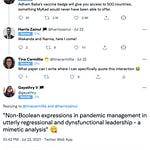You may misappropriate this newsletter
Kaitlyn Tiffany for The Atlantic: The women making conspiracy theories beautiful. Disguise and repackage QAnon conspiracies with Instagram beauty filters and don’t forget to hashtag #inspo.
Charlotte Jee for MIT Technology Review: Health misinformation pages got half a billion views on Facebook in April, almost four times as many views as information from reliable sources, according to an analysis by Avaaz. Only 16% of the health misinformation it analysed included a warning label.
Leo Benedictus for Full Fact: We don’t know whether misinformation killed 800 people. “This number comes almost entirely from alcohol poisoning deaths in Iran, which may have happened for other reasons.”
Social warming
Former technology editor at The Guardian Charles Arthur likens the gradual but eventual threat of misinformation to global warming. He calls it social warming:
With the spread of smartphones, social networks and people being connected all the time, we’re seeing something rather like we had with global warming. Where internal combustion engines, gigantic power companies burning fossil fuels led to the warming of the atmosphere, with smartphones and social networks, we are seeing a warming of society – social warming.
Just as we’re changing the atmosphere by putting more carbon dioxide into it – we’re changing the way society functions by putting more information into it, getting people to respond quicker, and that’s radically altering the way society functions.
To truly appreciate the social warming that’s happening, we need to go back in time. Way back to the 15th century. From syllabaries to alphabets, at that point in time, we had developed mature writing systems across the world. But it wasn’t until 1440 in Germany when Johannes Gutenberg invented the printing press. This was a machine that was able to transfer ink to paper.
Before, books were handwritten. That’s right – every single copy. It took a lot of time and effort, and of course, money. It was expensive, and only the rich and powerful could afford it. But the printing press was revolutionary. It allowed the mass production of books and other documents. By the 17th century, it spurred information sharing, making it one of the earliest and most influential steps to the democratisation of knowledge.
Fast forward to the 20th century: The Internet became accessible to the general public in the late ‘80s. There was great hope that the Internet would strengthen democracy. Like the printing press, the Internet has produced an explosion of accessible material.
With its incredible ease, speed, and low cost, this ‘information explosion’ causes concerns about accuracy and credibility. But rather than taking two centuries like the printing revolution, the democratisation of technology happened in less than three decades. Today, more than half of the entire population has Internet access.
“Big social networks use algorithms to drive people to spend more on them because the more time people spend on a social network, the more likely they are to see an ad. The social networks make money from ads,” says Arthur.
Big Tech also incentivise higher engagement to collect and provide as much data about their users to advertisers. So what happens when the likes of Amazon, Apple, Facebook and Google know us and our interests? Well, we receive ads and postings that accurately reflect our interests. And when we see things we like, it maximises the time we spend on their sites.
A passive selective exposure. A nudge to our behaviour. A virtuous circle.
The algorithms also prioritise content with greater prior engagement. That’s because users are more likely to stick around if they see content that already has a lot of retweets and mentions.
So even if your Twitter profile says “retweet does not mean endorsement,” you’re already doing the work for Big Tech. As long as enough of us react to a post, the newsfeed algorithm shows it to more users. It taps into their biases – prompting even more engagement, and so on. It creates a cycle, a confirmation bias machine.
“But driving people to spend more time on a social network doesn’t correlate with them having accurate information. There’s no mechanism for the algorithm to determine the truth of something. We’ve seen cases where people have been radicalised [because the] algorithm has led them down the rabbit hole of things that aren’t true, but which they find engaging. If we’re being told that these algorithms were being driven by aliens, we’d declare war on the aliens, but because they’re all built by engineers and Big Tech companies, we think they must be fine,” says Arthur.
NOTE: This is adapted from my 2019 podcast miniseries, Ring True.
What I read, watch and listen to…
I’m reading A Science Writer’s Guide to Data Journalism.
I’m (re)listening to Kelvin Yee’s 2016 podcast series, Lingo about “our relationship with language, how it goes beyond communication, and the impact it has on our lives, cultures, and traditions.” Suggested episodes include:
Chart of the week
From Thibault Schrepel’s article on tech regulation. For the record, most tech scholars accept that technology is deterministic and non-neutral.
Istilah semasa – cepat, tepat, jelas, dan menarik?
Kadang kala, saya mengkritik Dewan Bahasa dan Pustaka kerana pengenalan dan penerangan istilah terjemahan semasa atau baharu yang lembap, kurang sempurna, mengelirukan dan/atau pekak nada (tone deaf). Seperti dengan ejaan sebenar penjarakan sosial, yang saya terangkan sebelum DBP juga berbuat sedemikian hampir tiga minggu kemudian.
Saya berpendapat lebih baik membiasakan penggunaan istilah teknikal dalam media arus perdana dan media sosial dengan cepat, tepat, jelas dan menarik sehinggalah ia tidak perlu diterangkan lagi maksudnya, atau memperkenalkan istilah baru sekiranya istilah semasa tiada, sebelum kata pinjaman dijadikan kebiasaan.
Antara istilah-istilah semasa berkaitan COVID-19 yang kini telah diperkenalkan dalam perbualan harian termasuklah: pelitup muka, penyahjangkit, pensanitasi tangan, kelengkapan perlindungan diri, kit ujian pantas, pengesanan kontak, penyaringan massa, dan lain-lain. Sesudah diperkenalkan istilah-istilah ini, gunakanlah ia dalam tuturan harian dan bukannya meminjam daripada bahasa lain. Tak perlulah guna perkataan fesmask yang tak molek dan menarik.
Contoh yang sering saya guna pakai adalah apabila virus Zika menjadi epidemik di benua Amerika sekitar tahun 2015 dan 2016. Antara gejalanya ialah mikrosefali dalam kalangan bayi baru lahir. Perkataan mikrosefali itu ialah istilah teknikal yang pada awal laporannya di media tempatan, perlu diberi definisinya, yakni keadaan saiz kepala yang kecil, dan biasanya dikaitkan dengan perencatan mental. Lama kelamaan, istilah itu disebut sahaja tanpa perlu penerangan lanjut, kerana sudah menjadi lazim.














